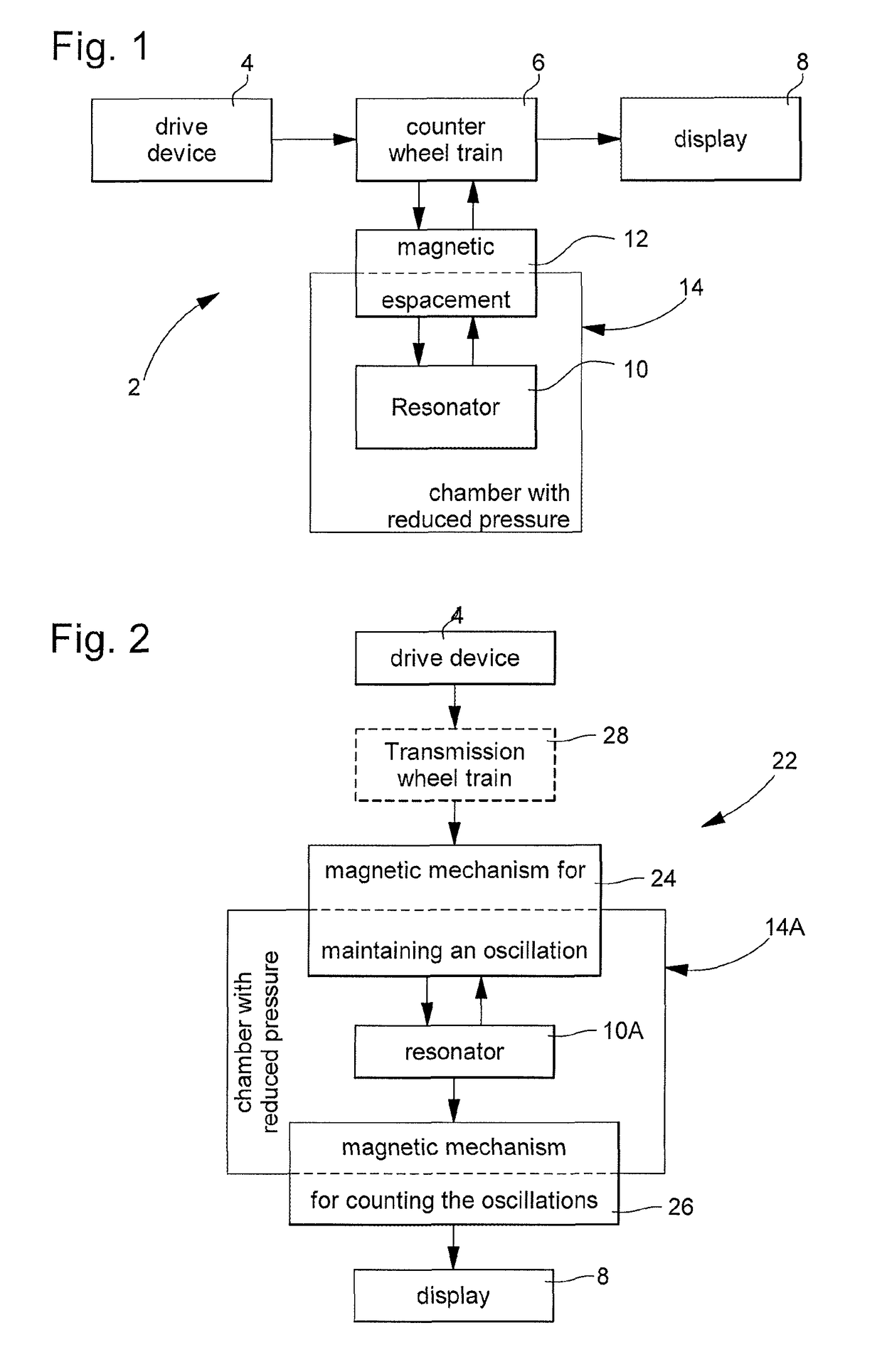Mechanical clock movement with magnetic escapement
a mechanical clock and escapement technology, applied in the field of mechanical clock movement, can solve the problems of reducing pressure affecting etc., and achieves the effects of reducing mechanical friction, reducing power, and increasing the working precision of the watch
- Summary
- Abstract
- Description
- Claims
- Application Information
AI Technical Summary
Benefits of technology
Problems solved by technology
Method used
Image
Examples
first embodiment
[0028]It will be observed that the magnetic mechanism for maintaining oscillation can be similar in design to a magnetic escapement such as that of the first embodiment, and can therefore correspond, for example, to one of the particular embodiments that will be described below. The same observation applies to the counting and drive magnetic mechanism. In particular, at least one of these two magnetic mechanisms comprises an escape wheel coupled directly or indirectly to the resonator 10A via a magnetic coupling system. This magnetic coupling system is formed from at least one first magnetic element and a second magnetic element that exhibit at least periodically a magnetic interaction between them. According to the invention there is provided a hermetically sealed chamber 14A, which comprises a wall running between the first and second magnetic elements, so that the first magnetic element is inside the chamber, whereas the second magnetic element and the escape wheel are outside th...
third embodiment
[0033]The operation of the magnetic escapement of this third embodiment will not be described in detail here. The person skilled in the art will find detailed explanations as well as improved embodiments of such a magnetic escapement in European Patent Application EP 14176816, or in a patent application claiming the priority of this European Application. In general, a force couple is supplied to the escape wheel 36 by the drive device via the pinion wheel 50 to drive this escape in rotation. The magnets are configured and arranged so that the rotation of the wheel 36 stimulates the resonator such that the branches of the tuning fork start to vibrate and the small plates 58A and 58B start to oscillate. The magnetic interaction between the magnets in a variant in magnetic repulsion is provided so that the magnetic coupling system periodically accumulates potential magnetic energy, which it gives back at least to a major part to the resonator in each period when a magnet 40 exits radia...
fourth embodiment
[0043]The variant of the fourth embodiment shown in FIGS. 5 and 6 is noteworthy in that the clock movement 72 largely incorporates components and elements of traditional clockmaking while using a magnetic coupling system without contact between the anchor and the escaped wheel to allow a wall 112 of a hermetically sealed chamber 80 to be located between first and second parts of this magnetic coupling system of the escapement.
[0044]A fifth embodiment of a clock movement according to the invention is described below with reference to FIGS. 7, 8 and 9A to 9D. The mechanical clock movement 152 comprises a resonator 154 and a magnetic escapement 156 shown in the figures. As in the fourth embodiment, this magnetic escapement comprises an escape wheel 158, which is coupled to the resonator by an intermediate member 160 formed by an anchor defining a bistable retaining catch. In contrast, this fifth embodiment differs from the previous embodiment in that the magnetic coupling system of the...
PUM
 Login to View More
Login to View More Abstract
Description
Claims
Application Information
 Login to View More
Login to View More - R&D
- Intellectual Property
- Life Sciences
- Materials
- Tech Scout
- Unparalleled Data Quality
- Higher Quality Content
- 60% Fewer Hallucinations
Browse by: Latest US Patents, China's latest patents, Technical Efficacy Thesaurus, Application Domain, Technology Topic, Popular Technical Reports.
© 2025 PatSnap. All rights reserved.Legal|Privacy policy|Modern Slavery Act Transparency Statement|Sitemap|About US| Contact US: help@patsnap.com



